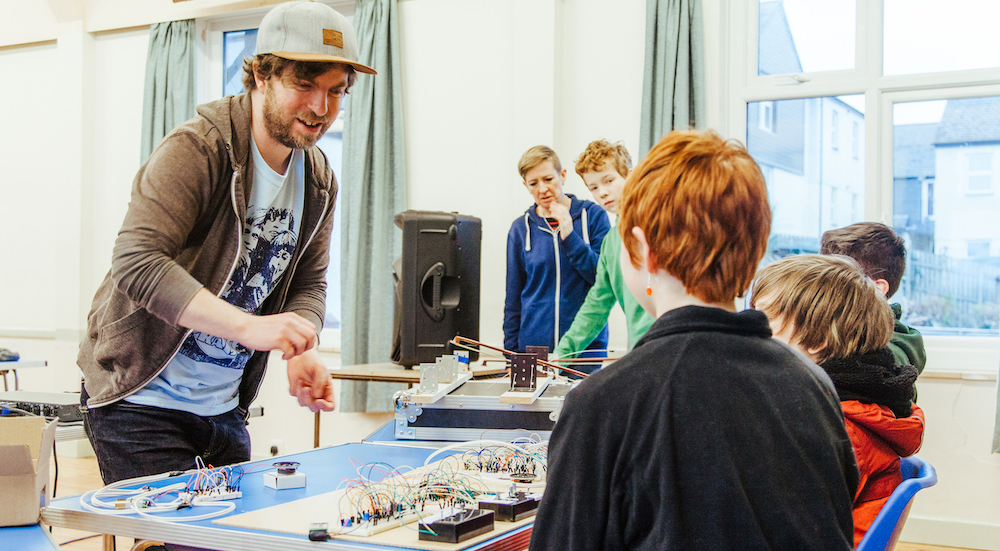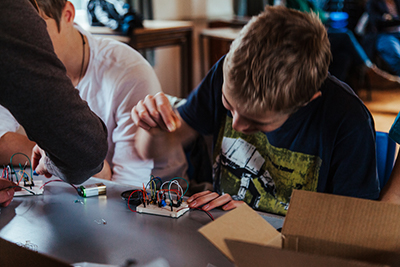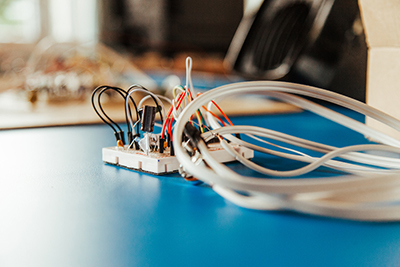Item added to basket:
{{_page.AddedItem.TotalPriceText}}
Suggested Queries
- {{query}}
- {{suggestions.ScopedQuery}} in {{scope}}
Brands
- {{brand.contentName}}
Categories
- {{tier.contentName}}
Other Suggestions
- {{page.contentName}}

If you thought that making music involved tinkling at the piano or strumming a guitar, think again. Sticking some electronics components and jumper wire into a breadboard, twiddling some knobs, connecting them up to an amplifier, and boom, you have sounds! Of course, the thing we call rock n’ roll was made possible through electronics and the difference an amplifier made to the sound, tone and volume of guitar strings.
It is those kind of sounds that inspire Cornish-based experimental musician Matt Ashdown. His participatory arts organisation Moogie Wonderland developed out of Matt’s interests in music and participatory art. A DJ and guitar player, after studying Fine Art he started an artist-run clubnight playing electronic music and indiepop. He then started making his own instruments which he invited people to play and improvise with. As well as parties and interactive art installations he also runs educational events under the co:noise name, which are designed to encourage children to tinker with electronics and even perform improvised pieces with the sounds they make.
Rapid has helped support the co:noise project by contributing components and equipment, alongside generous grants from a number of funders.
The funding has enabled Matt to develop tutorials for projects such as breadboard synthesizers and amplifiers, as well as produce kits that can be used in the co:noise workshops. The components for all of these projects are available from Rapid. They are a great way for children to get creative with very little cost.

Matt Ashdown at a co:noise workshop
“It started from those concerts where we were inviting people to play instruments on stage with experienced musicians regardless of experience”, says Matt. “I spent a while wondering how people could do that at home because it could solve the problem many people face of not being able to afford music lessons or instruments, or who want to learn music in a way that is more suitable than learning to read traditional music. If I could show children how to make electronic instruments on a small budget, without needing to have a soldering iron, they could make them at home and explore how to play them alone or with friends - it can be a social thing.”
Matt realised that the creativity in building electronic instruments was similar to the creativity in using modular synths. “It's kind of instantly modular if you consider electronic components as modules themselves: you can take a resistor out and replace it with a different one to make a different pitch; replace a potentiometer with an LDR to change the way you perform the sound; add one circuit to another to modulate the sound.”
“The co:noise tutorials and workshops do all that.”
The workshops have had some great feedback too – that’s nice things that people have said, rather than guitar distortion! Although plenty of that too. “Lots of lovely noise and my son was so proud of his synth” was one comment from a parent, while a secondary school teacher said that “we only show children how to use standard instruments and we can’t do things on the music tech side of things, so this has been brilliant for the them. It’s such a different side of making music that they are used to.”
As Matt says: “This project is something for girls and boys to enjoy alike - at one workshop we ran, a girl looked at the electronic instruments laid out and commented that it was ’going to be a workshop for boys’, but she got involved and soon realised it wasn’t and went away really inspired and enthused.”
Matt is steeped in experimental music. His favourite artists include Sonic Youth, Suzanne Ciani, Steve Reich and Stereolab. He founded the band Mildred Maude in 2014, a three-piece notable for the fact that they have only one song, “CPA”, which is constantly evolving through improvisation and different recordings, edits, mixes and live performances. Expect howling feedback, ferocious drumming, rumbling bass but also plenty of tunefulness – a bit like Mogwai or a more melodic My Bloody Valentine.

© Chris Trevana
“The website was easy to use, and the components were all there. We wanted to have a supplier that had everything we needed in one place so that children or their parents wouldn't have to look at multiple sites. I also saw that you do things to support communities, and that is something that all companies should be doing in some way.”
At the time of writing, in March 2020, the coronavirus has seen schools close across the UK. Social gatherings have been banned, so there will be no more workshops for a while, but home schooling provides Matt with another platform to make some co:noise.
“We are looking into building the online 'how-to' instructions more on our website www.moogiewonderland.co.uk. It's something that children and their parents can do at home and it doesn't cost too much – if you get the components and a variety of resistors, capacitors and potentiometers, there is a lot you can do with a simple synthesizer such as a square wave oscillator - so it makes sense to make people aware of this now.”
“We are also planning a project to encourage children to create graphic scores (such as a drawing or a collage) that can then be shared online for other children to improvise music as they interpret the unconventional score - hopefully using instruments they’ve built themselves!”
“As soon as we are able to, we want the co:noise project to turn into a more regular thing – an electronic instrument building club, more ‘how-to’ instructions, and even an experimental orchestra with different sections. We also want to start introducing the idea of graphic notation, which was pioneered by the likes of John Cage and Karlheinz Stockhousen and is well suited to electronic music.”
Bring the co:noise!

© Chris Trevana
Website: www.moogiewonderland.co.uk
Twitter: moogietweets
Facebook: moogiewonderland
Instagram: moogiewonderland